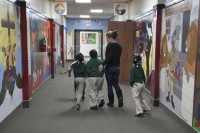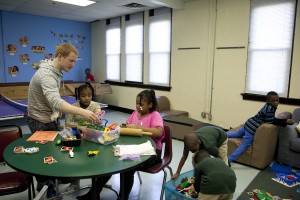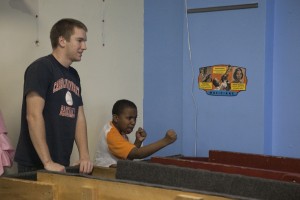
Studying prime issues in Chicago, such as race and crime, five college sophomores and a professor from Carroll University in Wisconsin visited Austin last week for a required course titled “Cross Cultural Chicago.”
Visiting for a little more than a week and spending majority of their time working with elementary students from Catalyst Circle Rock Charter School enrolled in the Circle Urban Ministries after-school program, the Carroll University students traveled more than two hours from Waukesha to immerse themselves in Chicago’s neighborhoods.
 A signature component of Carroll’s general education curriculum, “Cross Cultural Chicago” challenges students to examine cultural differences by interacting with communities other than their own in an off-campus setting. In addition to spending time in Austin, each student was assigned a different community, such as Chinatown or Albany Park, for comparative purposes.
A signature component of Carroll’s general education curriculum, “Cross Cultural Chicago” challenges students to examine cultural differences by interacting with communities other than their own in an off-campus setting. In addition to spending time in Austin, each student was assigned a different community, such as Chinatown or Albany Park, for comparative purposes.
“I’m hoping after this experience in Austin the students will be comfortable crossing cultural boundaries and will be open minded and able to work with people from very different backgrounds,” said Fred Beuttler, director of general education at Carroll University. “It’s so often easy to shrink back and return to your own little bubble, but instead I want the students to want the excitement of meeting new people and new cultures and explore new places like Chicago’s urban environment.”
Beuttler spearheaded the course, basing the majority of his assignments on his personal experiences in Austin; he lived on the border of Oak Park and Austin for 12 years.
Each college student is majoring in pre-physical therapy, and Beuttler said treating patients requires cultural sensitivity, and one of the most important components of that is persuading someone to be comfortable with close contact.
“Austin is much more of a homogeneous population than what I’m used to… Austin is very much it’s own neighborhood within Chicago and it was nice to come into an area with such a strong sense of community,” said Matthew Buettner, 20, a sophomore at Carroll who visited last week.
Born-and-raised in Green Bay, Buettner said that although he was raised in an urban environment similar to Chicago, he was  surprised to see Austin have much more of a family-oriented culture. He also visited Rogers Park for cross-cultural comparison.
surprised to see Austin have much more of a family-oriented culture. He also visited Rogers Park for cross-cultural comparison.
“From Rogers Park and Austin, I saw that Chicago is so much more than a tourist city,” he said. “There are actually people who live here, which I obviously realized before, but you don’t really get a sense of that from visiting downtown; I was definitely exposed to the reality of people who live in Chicago’s communities.”
Homework assignments for the students’ week in Chicago included the development of an “urban portfolio,” which consists of found articles, a report on their neighborhood’s urban landscape and a persuasive essay related to a neighborhood issue for which a culturally sensitive solution must be proposed. Each student also kept a reflective journal throughout the time spent in Chicago and used it to draw connections between the course readings and in-neighborhood experiences.
Some of the course readings included “Chicago Poems” by Carl Sandburg, “Ethnic Chicago” by Richard Lindberg, “The New Jim Crow: Mass Incarceration in the Age of Colorblindeness” by Michelle Alexander and “Breaking Down Walls: A Model for Reconciliation in an Age of Racial Strife” by Raleigh Washington and Glen Kehrein.
“This has definitely been a different experience for me, something far from what I’m primarily used to,” said Katie Brito, 20, a sophomore at Carroll and originally from Antioch, Ill. “I never would have come to the West Side of Chicago, but if you’re smart about where you’re going and what you’re doing, you could be exposed to a completely unique way of life.”
 Brito studied Albany Park for a comparative analysis with Austin.
Brito studied Albany Park for a comparative analysis with Austin.
Brito said that she’d like to go into pediatric physical therapy and her favorite part of visiting Austin with working with the children at Circle Urban Ministries. She said she’d come back to Austin to work with the after-school program “in a heartbeat.”
“I wouldn’t walk around this neighborhood at night by myself, especially being a female, but every neighborhood has bad and good parts, and this week I definitely saw a really positive side of Austin,” she said. “The kids have just been fantastic.”